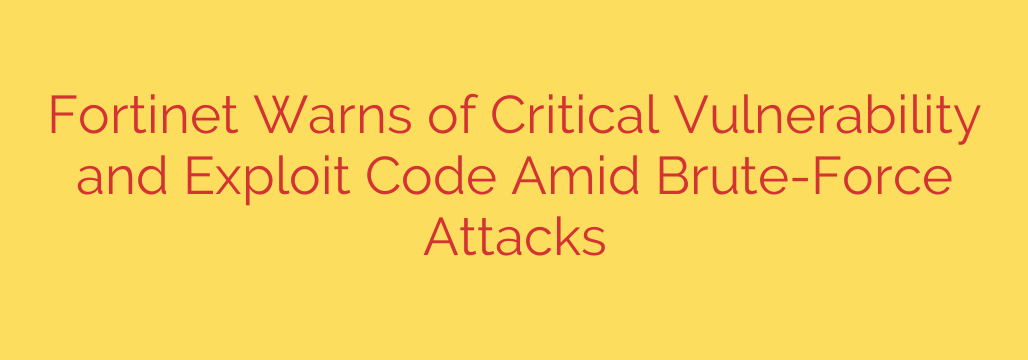
Urgent Security Alert: Critical Fortinet Flaw Under Active Attack
Cybersecurity teams are on high alert following the discovery of a critical vulnerability in Fortinet’s FortiOS SSL VPN. This security flaw is not just a theoretical risk; it is being actively exploited in the wild, often in conjunction with widespread brute-force attack campaigns. If your organization uses Fortinet products, immediate action is required to prevent a potential breach.
The vulnerability, tracked as CVE-2024-21762, carries a critical severity rating of 9.6 out of 10. It is an out-of-bounds write vulnerability in the FortiOS SSL VPN, which can be exploited by an unauthenticated, remote attacker.
Successful exploitation of this flaw could allow a malicious actor to gain complete control over an affected system through remote code execution. This means an attacker could potentially access sensitive data, disrupt network operations, or use the compromised device as a pivot point to launch further attacks within your network.
Which Devices Are At Risk?
The vulnerability impacts a wide range of Fortinet products. It is crucial to check if your systems are running any of the following affected versions:
- FortiOS 7.4: Versions 7.4.0 through 7.4.2
- FortiOS 7.2: Versions 7.2.0 through 7.2.6
- FortiOS 7.0: Versions 7.0.0 through 7.0.13
- FortiOS 6.4: Versions 6.4.0 through 6.4.14
- FortiOS 6.2: Versions 6.2.0 through 6.2.15
- FortiProxy: Specific versions are also affected; check vendor advisories for details.
The situation is made more urgent by the fact that proof-of-concept (PoC) exploit code is publicly available. This lowers the barrier for less-skilled attackers to target vulnerable systems, dramatically increasing the pool of potential threats.
The Threat: Active Brute-Force Campaigns
Security researchers have observed that threat actors are actively scanning for and exploiting this vulnerability. These targeted attacks are often part of broader brute-force campaigns aimed at compromising administrator accounts on Fortinet devices.
A brute-force attack involves systematically trying vast combinations of usernames and passwords to gain unauthorized access. Attackers are using common and default credentials like “admin,” “fortinet,” and “root” in their attempts. If they succeed, they can disable security features, steal data, or deploy malware.
Immediate Steps to Secure Your Network
Protecting your organization from this threat requires swift and decisive action. Waiting is not an option, as automated attacks are actively scanning the internet for unpatched devices.
1. Patch Your Systems Immediately
The most important step is to update your devices to a patched version as soon as possible. Fortinet has released security updates to address this vulnerability. Applying these patches is the only way to fully remediate the risk.
2. Disable SSL VPN if Patching is Not Possible
If you cannot apply the patch immediately, the recommended workaround is to completely disable the SSL VPN functionality on your FortiGate devices. While this may impact operations, it is a necessary measure to prevent exploitation until a patch can be applied.
3. Enforce Strong Password Policies
To defend against the ongoing brute-force attacks, ensure all administrative accounts have strong, unique passwords. Avoid using default credentials and enforce a policy that requires complex passphrases that are not easily guessable.
4. Enable Multi-Factor Authentication (MFA)
MFA is one of the most effective defenses against credential-based attacks. Activating MFA on all administrator and VPN user accounts provides a critical layer of security that can block attackers even if they manage to steal a password.
5. Monitor for Suspicious Activity
Regularly review system logs for signs of compromise. Look for repeated failed login attempts from unknown IP addresses, unexpected system reconfigurations, or any unusual outbound traffic. Early detection is key to mitigating the impact of a potential breach.
In today’s threat landscape, proactive security is non-negotiable. The existence of a critical, remotely exploitable vulnerability with public exploit code demands your full attention. Take these steps now to secure your network and protect your organization from a potentially devastating cyberattack.
Source: https://go.theregister.com/feed/www.theregister.com/2025/08/13/fortinet_discloses_critical_bug/








